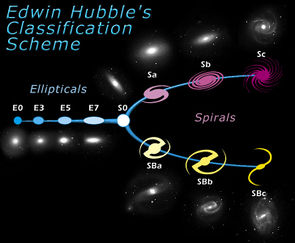Hubble Sequence
 From Conservapedia
From Conservapedia The Hubble sequence is a scheme for classifying galaxies.[1] Developed in 1926 by Edwin Hubble, it splits galaxies into two major groups: elliptical galaxies and spiral galaxies. Nowadays, it is understood to be too simple a classification scheme. It is sometimes called the "Hubble tuning fork diagram" due to its resemblance to a tuning fork.
Contents
Galaxy Types[edit]
Elliptical Galaxies[edit]
Elliptical galaxies are shaped like an ellipse and are classified as "En" where n is an integer between 0 and 7 relating to the galaxies eccentricity. A galaxy with a higher n is more eccentric, so that an E0 galaxy is circular while and E7 galaxy is very elongated. Elliptical galaxies are called "early-type" as Hubble originally believed that galaxies evolved from ellipticals into spiral galaxies.[2] This is not thought to be true now but the name still sticks. Elliptical galaxies form the handle of the tuning fork.
Spiral Galaxies[edit]
These are galaxies that are shaped like a disk and contain spiral arms. They are split into two categories depending on whether the bulge contains a bar or not and form the prongs of the tuning fork. If a bar is present, they are labelled "SB", otherwise just "S".[1] They are further classified by assigning the letters "a", "b" and "c", depending on how tightly wound their spiral arms are. The letter "a" is assigned to those with the tightest winding and "c" to the least tightly wound. Type b is located in between. The size of the bulge also appears to follow a pattern, with type a galaxies containing a large bulge and type c a small bulge.[1] They are called "late-types" as Hubble believed they evolved from elliptical galaxies but this is known not to be the case.[2]
Lenticular Galaxies[edit]
Lenticular galaxies occur where the handle joins the two prongs of the tuning fork. They are classified as "S0" and bridge the two main types.[1] These galaxies have the bulge and disk present in spiral galaxies, but do not have spiral arms.[2]
Irregular Galaxies[edit]
Some galaxies do not fit into the above types and are called irregular galaxies.
References[edit]
- ↑ 1.0 1.1 1.2 1.3 The Hubble tuning fork diagram from spacetelescope.org
- ↑ 2.0 2.1 2.2 Hubble tuning fork from skyserver.sdss.org
| |||||||||||||||||
Categories: [Astronomy]
↧ Download as ZWI file | Last modified: 03/04/2023 01:41:47 | 7 views
☰ Source: https://www.conservapedia.com/Hubble_sequence | License: CC BY-SA 3.0
 ZWI signed:
ZWI signed:
 KSF
KSF